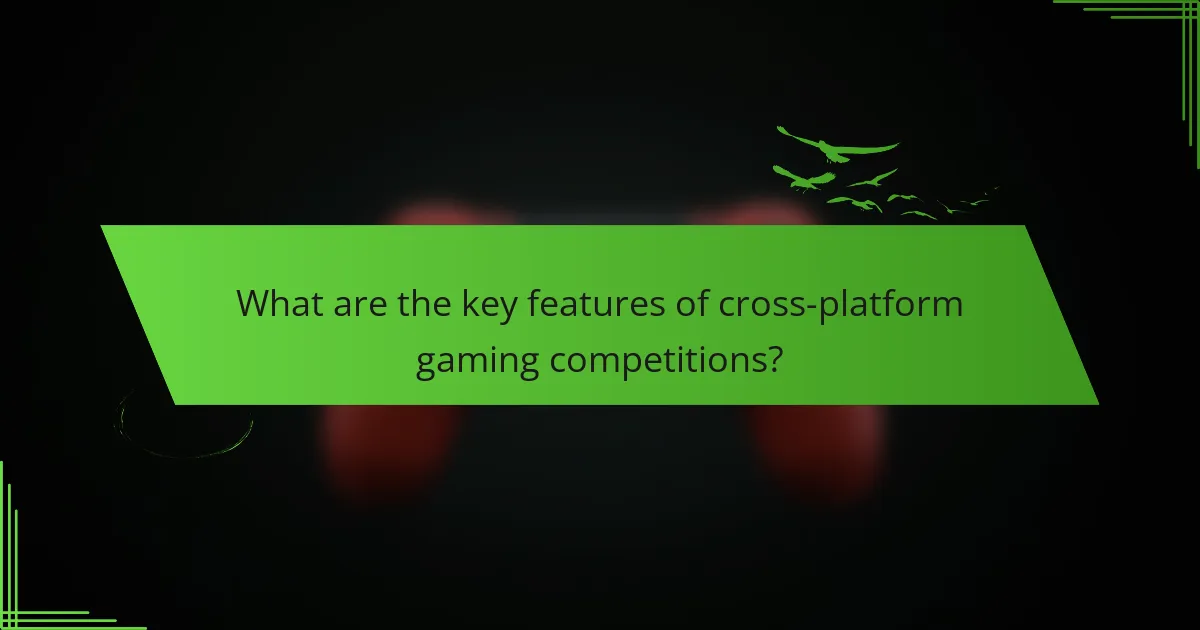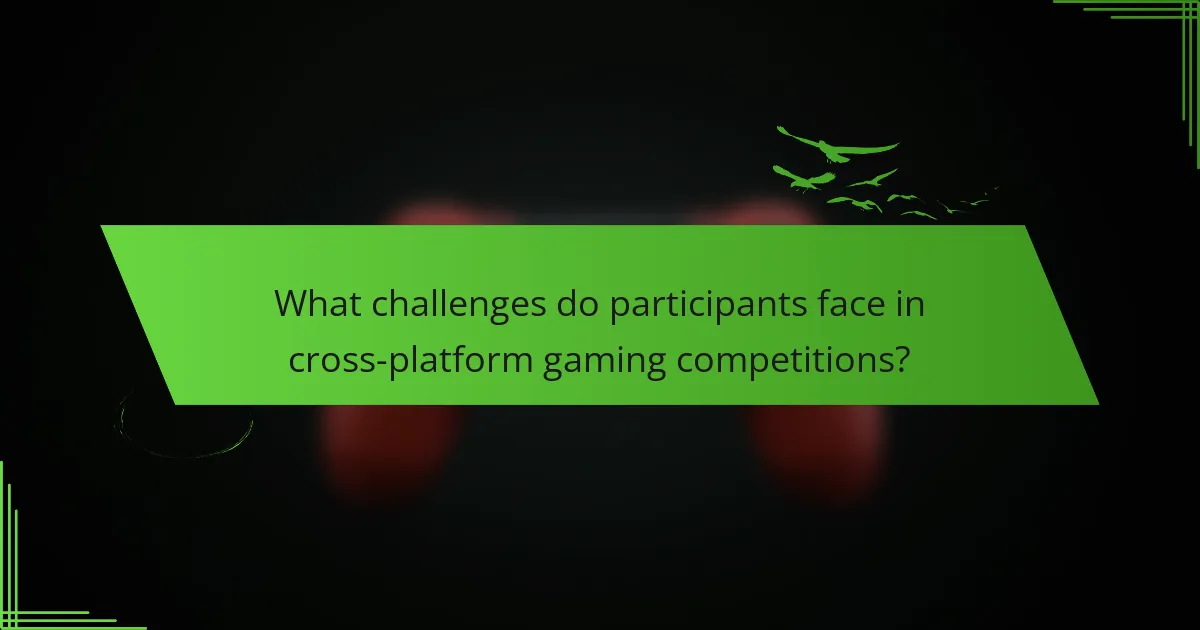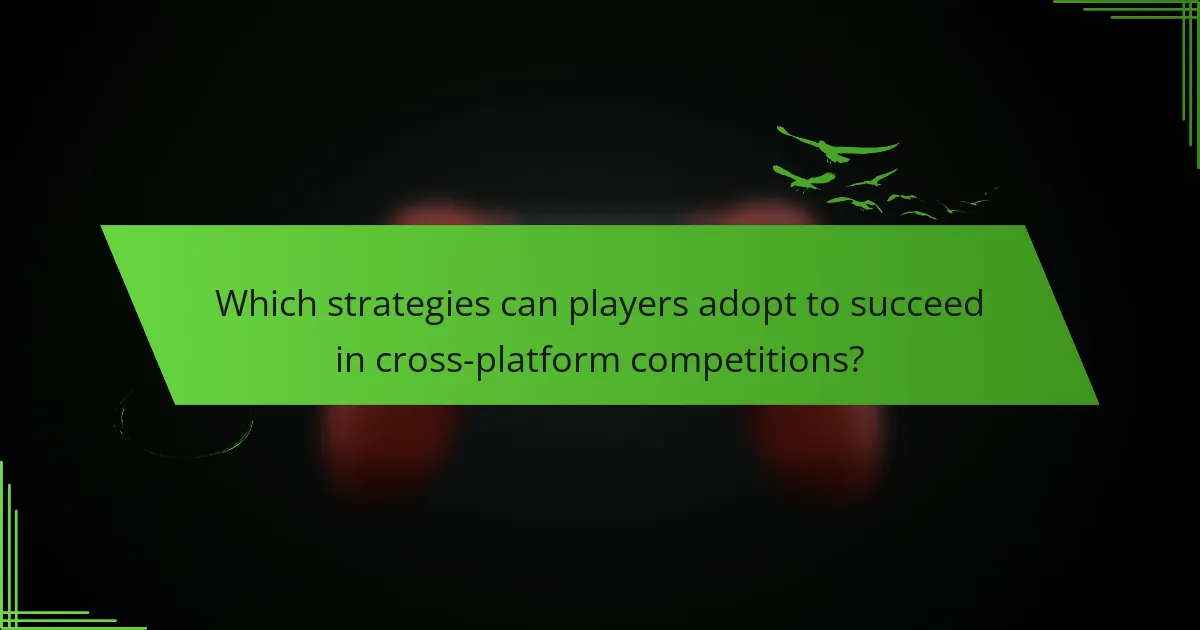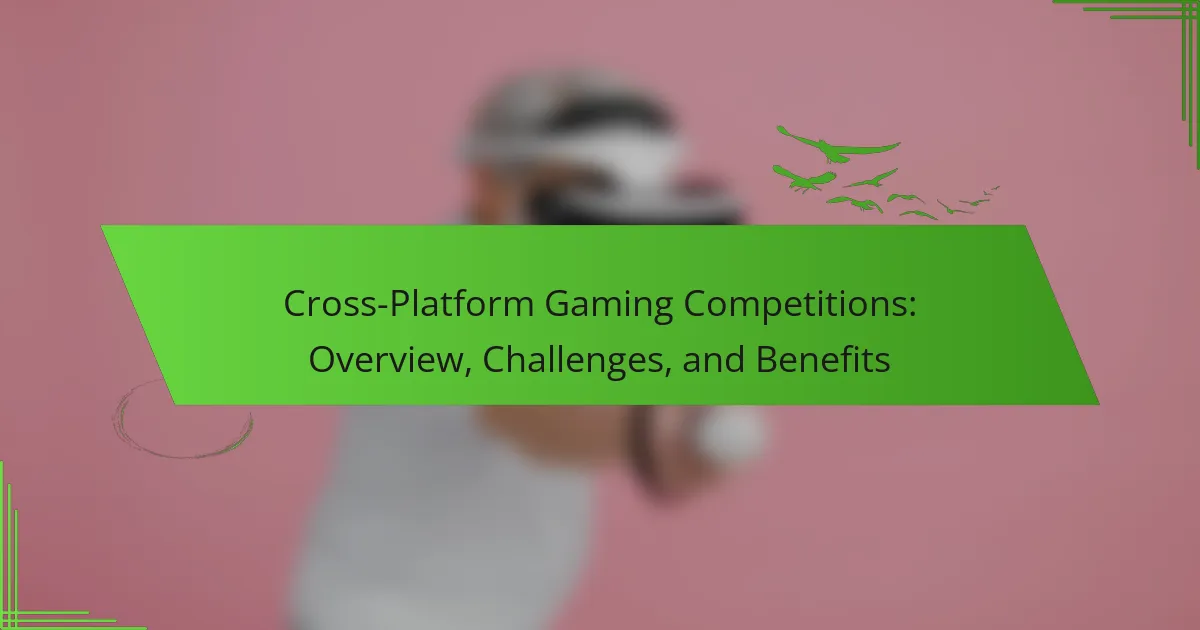Cross-platform gaming competitions enhance accessibility and foster community engagement among players from diverse platforms. They present challenges such as technical disparities and skill gaps. Key features include unified matchmaking systems and platform-agnostic tournaments. Emerging trends highlight increased technology integration and community-driven events, signalling a shift towards inclusivity in gaming.

What are the key features of cross-platform gaming competitions?
Cross-platform gaming competitions feature inclusivity, diverse player bases, and enhanced competition. They allow gamers from different platforms to compete, fostering community engagement. Key features include cross-play capabilities, unified matchmaking systems, and platform-agnostic tournaments. These aspects promote fairness and accessibility, appealing to a broader audience.
How do different gaming platforms interact in competitions?
Cross-platform gaming platforms interact in competitions by enabling players from different systems to compete against each other. This fosters inclusivity and expands the player base. However, challenges arise from varying hardware capabilities and input methods, which can affect gameplay balance. Benefits include a larger community and increased competition, enhancing player engagement and experience.
Which games are most popular in cross-platform competitions?
The most popular games in cross-platform competitions include Fortnite, Call of Duty: Warzone, Apex Legends, Rocket League, and Minecraft. These titles attract diverse player bases and showcase competitive play across various platforms. Fortnite leads with its large community and frequent updates. Call of Duty: Warzone offers intense battle royale experiences. Apex Legends combines teamwork and strategy. Rocket League innovates with vehicle-based soccer. Minecraft fosters creativity and collaboration.
What technological advancements support cross-platform gaming?
Technological advancements that support cross-platform gaming include cloud gaming, cross-platform APIs, and enhanced network infrastructure. Cloud gaming services allow players to access games on various devices without compatibility issues. Cross-platform APIs facilitate seamless interactions between different gaming systems, improving user experience. Enhanced network infrastructure reduces latency, ensuring smooth gameplay across platforms.

What challenges do participants face in cross-platform gaming competitions?
Participants in cross-platform gaming competitions face several challenges, including technical disparities, skill gaps, and community fragmentation. Technical disparities arise from differences in hardware and software performance across platforms, affecting gameplay experience. Skill gaps can occur as players from different platforms may have varying levels of experience and familiarity with game mechanics. Community fragmentation complicates matchmaking, as players might prefer to compete within their own platform’s ecosystem, limiting the pool of opponents. Additionally, balancing gameplay mechanics across platforms can be challenging, resulting in perceived unfair advantages.
How does matchmaking differ across platforms?
Matchmaking in cross-platform gaming varies significantly due to differences in player skill levels, game mechanics, and platform capabilities. Each platform has unique matchmaking algorithms that account for these factors.
For example, console players may have different control schemes compared to PC players, which can affect performance. Additionally, matchmaking systems often prioritise balancing teams based on player rankings, making cross-platform matches more complex.
As a result, players may experience varying levels of competitiveness and fairness in matches across different platforms. This can lead to challenges in achieving equitable gameplay, but it also enhances the gaming experience by fostering diverse interactions.
What are the common technical issues encountered?
Common technical issues in cross-platform gaming competitions include connectivity problems, performance discrepancies, and compatibility errors. These challenges can hinder player experience and fairness. Connectivity issues often arise from different network standards, while performance discrepancies result from varying hardware capabilities. Compatibility errors occur when games do not function uniformly across platforms. Addressing these issues is crucial for smoother gameplay and improved competition outcomes.
How do player skill disparities impact competition?
Player skill disparities can significantly impact competition by creating imbalances that affect gameplay dynamics. In cross-platform gaming, varying skill levels can lead to frustration for less experienced players and diminish the competitive integrity. For example, a highly skilled player may dominate matches, reducing the enjoyment for others. This can result in a less engaging experience and may discourage participation in future competitions. Balancing skill levels through matchmaking systems is essential to ensure fair competition and maintain player engagement.

What benefits do cross-platform gaming competitions offer to players?
Cross-platform gaming competitions offer players increased accessibility, enhanced community engagement, and improved skill development. Players can compete with friends regardless of their gaming platform, fostering inclusivity. This format also encourages collaboration and communication among diverse gaming communities. Additionally, participating in these competitions helps players refine their strategies and techniques, enhancing their overall gaming experience.
How do these competitions enhance community engagement?
Cross-platform gaming competitions enhance community engagement by fostering collaboration and connection among diverse players. These events create opportunities for social interaction, skill-sharing, and collective problem-solving. Participants often form teams, leading to friendships and networks that extend beyond gaming. Additionally, competitions promote inclusivity, allowing players from different backgrounds to compete on a level playing field. This shared experience strengthens community bonds and encourages ongoing participation in gaming activities.
What are the economic advantages for developers and players?
Cross-platform gaming competitions provide significant economic advantages for developers and players. Developers can reach a larger audience, increasing revenue through diverse platforms. Players enjoy lower costs as they can compete without needing multiple devices.
Additionally, cross-platform play fosters community growth, enhancing player retention and engagement. This interconnectedness can lead to more sponsorship opportunities and higher prize pools, benefiting both developers and participants.
The unique attribute of cross-platform gaming is its ability to unify different gaming communities, creating a more vibrant ecosystem. As a result, the overall economic impact is amplified, driving innovation and investment in the gaming industry.
How does cross-platform play influence player retention?
Cross-platform play significantly enhances player retention by broadening the player base and fostering community engagement. Players are more likely to stay active when they can compete with friends across different platforms. This inclusivity creates a larger, more diverse gaming environment, which can lead to increased competition and social interaction. As a result, games that support cross-platform play often experience lower churn rates and higher long-term engagement.

Which strategies can players adopt to succeed in cross-platform competitions?
Players can adopt several strategies to succeed in cross-platform competitions. First, mastering the game mechanics is crucial, as understanding controls and gameplay can significantly impact performance. Second, developing strong communication skills enhances teamwork, especially in multiplayer settings. Third, practicing consistently across all platforms helps players adapt to different controls and environments. Fourth, analysing opponents’ strategies allows players to anticipate moves and counter effectively. Finally, utilising cross-platform tools and resources can provide valuable insights and improve overall gameplay.
What training methods are most effective for cross-platform players?
The most effective training methods for cross-platform players include practicing with diverse gaming styles, utilising cross-platform tools, and engaging in community challenges. These methods enhance adaptability and improve overall performance. Regularly analysing gameplay footage also helps identify strengths and weaknesses. Collaborative play with skilled teammates fosters strategic growth and teamwork skills.
How can players leverage platform-specific advantages?
Players can leverage platform-specific advantages by utilising unique features of each platform. For example, console players may benefit from exclusive titles, while PC players can access mods and enhanced graphics. Understanding the strengths of each platform allows players to optimise their strategies. Cross-platform matchmaking can further enhance competitiveness by expanding player pools and fostering diverse gameplay experiences.

What future trends are emerging in cross-platform gaming competitions?
Emerging trends in cross-platform gaming competitions include increased accessibility, enhanced technology integration, and the rise of community-driven events. Accessibility allows players on different platforms to compete, broadening participation. Enhanced technology, such as cloud gaming, improves performance and user experience. Community-driven events foster engagement and innovation, creating unique competitive environments. These trends signify a shift towards inclusivity and technological advancement in gaming competitions.
How are esports organizations adapting to cross-platform formats?
Esports organizations are increasingly adapting to cross-platform formats by enhancing accessibility and player engagement. They implement unified competition rules to ensure fairness across different platforms. This approach allows players from various systems to compete directly, fostering inclusivity and broadening the player base. Additionally, organizations leverage technology to synchronise gameplay experiences and maintain competitive integrity. These adaptations not only boost viewership but also create diverse revenue streams through sponsorships and partnerships.
What role will artificial intelligence play in future competitions?
Artificial intelligence will enhance cross-platform gaming competitions by improving matchmaking, analysing player performance, and personalising experiences. AI algorithms can create balanced matches, ensuring fair competition. They can also provide insights into player strategies, helping teams refine their tactics. Additionally, AI can facilitate real-time feedback to enhance player skills. This integration will likely lead to more engaging and competitive environments.
Which emerging games are likely to dominate cross-platform competitions in 2025?
Several emerging games are poised to dominate cross-platform competitions in 2025, including titles like “Fortnite 2,” “Halo Infinite,” and “Call of Duty: Modern Warfare II.” These games leverage advanced graphics, cross-play capabilities, and engaging multiplayer experiences.
The rise of cloud gaming technology enhances accessibility, allowing players across different platforms to compete seamlessly. Additionally, the integration of esports features, such as ranked matches and tournaments, will likely drive competitive interest.
As a result, developers focusing on community engagement and regular content updates will be crucial in maintaining player interest. Games that foster collaboration and competition across diverse gaming ecosystems will stand out in the competitive landscape.
What best practices should players follow for optimal performance?
Players should prioritise practice, communication, and adaptability for optimal performance in cross-platform gaming competitions. Consistent practice enhances skills, while effective communication fosters teamwork. Adapting to different platforms and game mechanics is crucial for success.
1. Regular practice sessions to refine skills.
2. Clear communication with teammates for strategy alignment.
3. Adaptability to various gaming platforms and controls.
4. Analysing gameplay to identify strengths and weaknesses.
5. Staying updated on game patches and meta changes.



